Several weeks ago, after we published the “Impressions of America” post, we heard a comment from Michele, who had just moved to Porto from the US a week earlier. She asked if we could help her understand how to vote in US elections while living abroad. Given the importance of the mid-term elections in the US this fall, we felt this was a question that would be of interest to many of our readers…us included. We penciled it in on our calendar and I spent some time doing some research on absentee voting from overseas.
Before telling you what I’ve learned, I’ll give a disclaimer and an endorsement.
The Disclaimer:
I am not an expert in this area. I have not voted in a US election since we moved to Portugal. But I am an interested US citizen relaying information I’ve found, and am acting on, from publicly available sources.
The Endorsement
In his book, “The Fifth Risk” *, Michael Lewis (author of “Moneyball”, “Flash Boys”, “The Blind Side”, “The Big Short”, and others) did an in-depth investigation of work being done by career civil servants in several US government agencies.
What he found was that when you got down in the organizations, below the layers of political appointees (many of whom got their jobs as rewards for campaign donations and who sometimes had little knowledge of the purpose of their organizations and less interest in learning), what you find are thousands of career civil servants who dedicate their working lives to complex, and sometimes obscure, subject matter areas.
They work behind the scenes, unnoticed by most of us, and deliver results that keep the wheels of government turning and often contribute directly to our safety and well being.
In this post, I’m going to talk about how the Federal Voting Assistance Program (FVAP) provides accurate, actionable, nonpartisan information and assistance to US citizens living outside the US. Mr. Lewis did not include the FVAP in his book, but based on what I’ve seen from their website, I think they would make the cut.
We Can’t Avoid the Acronyms
We’re dealing with the government, right? That means there will be acronyms. And in this discussion there are three that will be repeated several times.
I’ve already introduced you to FVAP, the Federal Voting Assistance Program. It is an agency of the US government with a very focused mission: to ensure that US citizens living outside the US are able to fully exercise their right to vote.
The FVAP collects and organizes information on voter registration and absentee voting from all 55 States, territories, and the District of Columbia, and publishes it at fvap.gov.
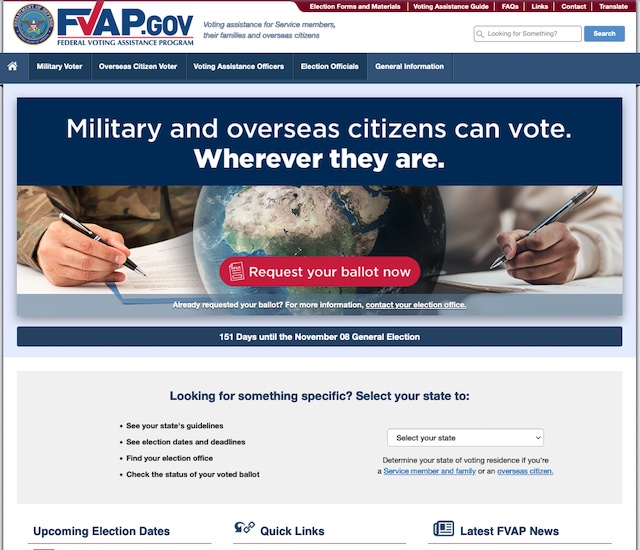
The second acronym is UOCAVA, which is short for Uniformed and Overseas Citizens Absentee Voting Act. This law provides the mandate for FVAP to operate. As they explain it (emphasis is mine):
UOCAVA citizens are U.S. citizens who are active members of the Uniformed Services, the Merchant Marine, the commissioned corps of the Public Health Service and the National Oceanic and Atmospheric Administration, their eligible family members and other U.S. citizens residing outside the United States. The law provides the legal basis for absentee voting requirements for federal offices.
Under this law, and subsequent amendments, states are required to send requested absentee ballots to UOCAVA voters no later than 45 days before a federal election.
The third, and last, acronym is FPCA, the Federal Post Card Application. The FPCA is a form you must fill out to register as an absentee voter and request your absentee ballot. You must submit a new application every year. Later in this post, I’ll walk you through how the form is completed.
The Two Step Process for Absentee Voting
On the FVAP website, the process for absentee voting from abroad is described as a two step process. It’s a bit more involved than that, but at a high level, the two steps are:
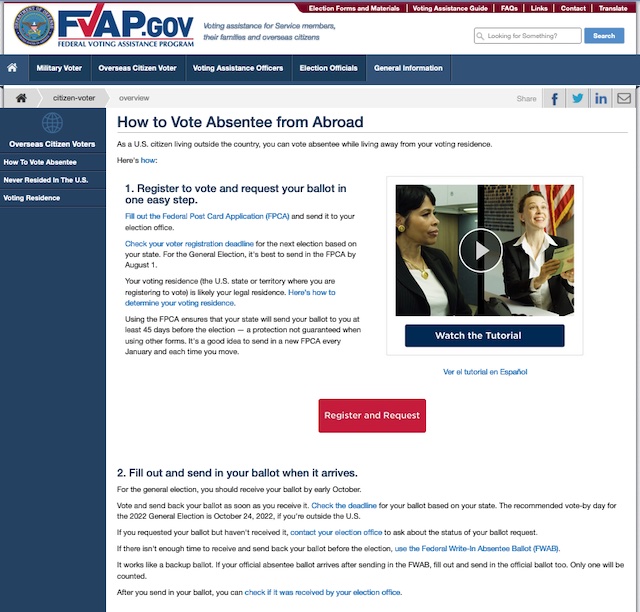
Step 1. Register to vote and request your ballot in one easy step
I finished Step 1 in about 30 minutes and my application was accepted within the hour. There were 11 screens (or sub-steps) to complete and some decisions and head scratching along the way. Keep reading and I’ll show you all the details.
Step 2. Fill out and send in your ballot when it arrives
We can’t do this one yet, because we haven’t received a ballot. But when it comes, you’ll want to send it back as soon as you receive it – especially if you have to send it via postal mail. More on this below.
Is It Really That Simple?
Anyone who has navigated any sort of government process, like filing your income tax or applying for a D7 visa, knows that what’s called “simple” in government speak usually isn’t. But this could be the exception.
To find out, I navigated through Step 1, completing all the activities successfully in less than 30 minutes. Then I read everything I could about Step 2. Here are my notes and some additional details that I discovered.
Step 1: Let’s Get Registered!
The TL;DR:
This section is going down into the weeds of how to register. If you’d like to skip these details, click here to jump ahead to the next section!
Completing Step 1 of the process required navigating through 11 screens on the FVAP web site. In this section, I’ll show you what I saw on each of those screens.
Step 1.1 – Get Started
When you click on a link to Fill out the Federal Post Card Application (FPCA), you will be presented with this screen that gives you an overview of the process and asks you to agree to their privacy statements.
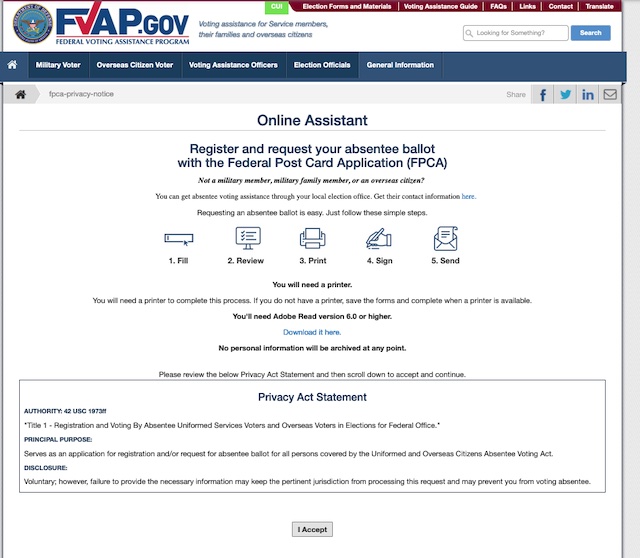
Note the requirement in mid-screen: You will need a printer. In order to submit the FPCA, you have to print out the application and sign it. Since I have a printer, this wasn’t an issue, but it could be for others. I do not know if an FPCA with a digital signature would be accepted. (That’s something to investigate later.)
Once you click on “I Accept”, you’ll move to
Step 1.2 – Select Your State of Voting Residence
This screen starts to show the magnitude of what the FVAP site is doing. We know that elections are administered at the state and local level in the US. But here is one page that provides a gateway to all of the states and territories.
It is important to understand the concept of “Voting Residence”, as it determines your selection in this step and several others. If you’ve moved to Portugal, or anywhere else outside the US, what is your “voting residence”? FVAP provides some very specific guidance on their page “How to Determine Your Voting Residency” They define it this way
Your voting residence is your address in the state in which you were last domiciled, immediately prior to leaving the United States.
This residence may remain valid even if:
- You no longer own property or have other ties to that state.
- Your intent to return to that state is uncertain.
- Your previous address is no longer a recognized residential address.
For the purposes of this post, I will complete each step with my information. I was a resident of Indiana, so what you see in subsequent steps may differ if you are from a different state.
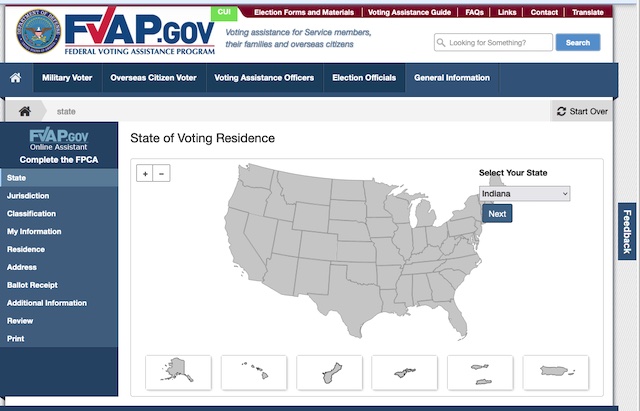
Step 1.3 – Select Your Jurisdiction
The drop-down menu on this screen shows a list of all the counties in Indiana. Again, you may see something different. I know I was registered to vote in Marion County, so that’s what I selected. If you’re not sure, you can click on the link to the “Indiana Election Website”. That will take you to a page where you can check your registration record.
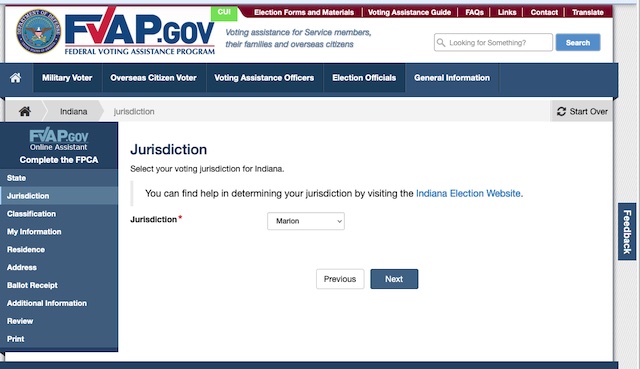
Step 1.4 – Select your Absentee Ballot Classification
Pick the option that best describes your situation. A note on the site FAQ indicates that your response has no impact on your citizenship.
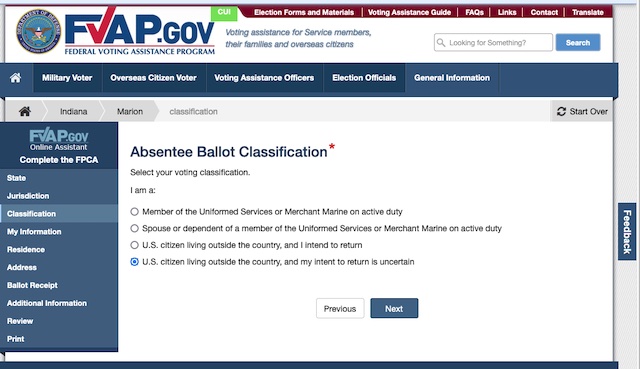
Step 1.5 – Enter Your Personal Information
These items are mostly self-explanatory. Note the point about indicating your political party preference if you want to vote in primary elections. Some states may handle this in other ways.
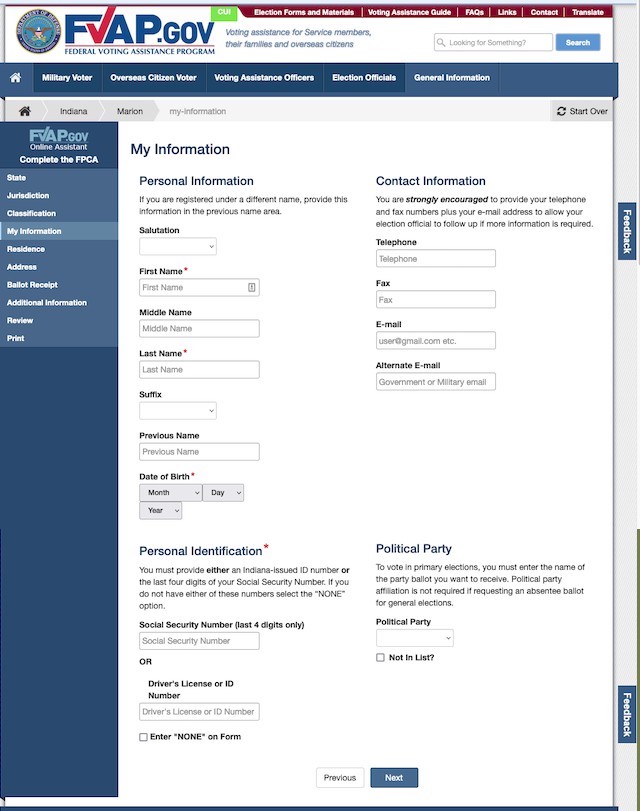
Step 1.6 – Address Information
Here you’ll enter the address for your “voting residence”, as determined in Step 1.2 above.
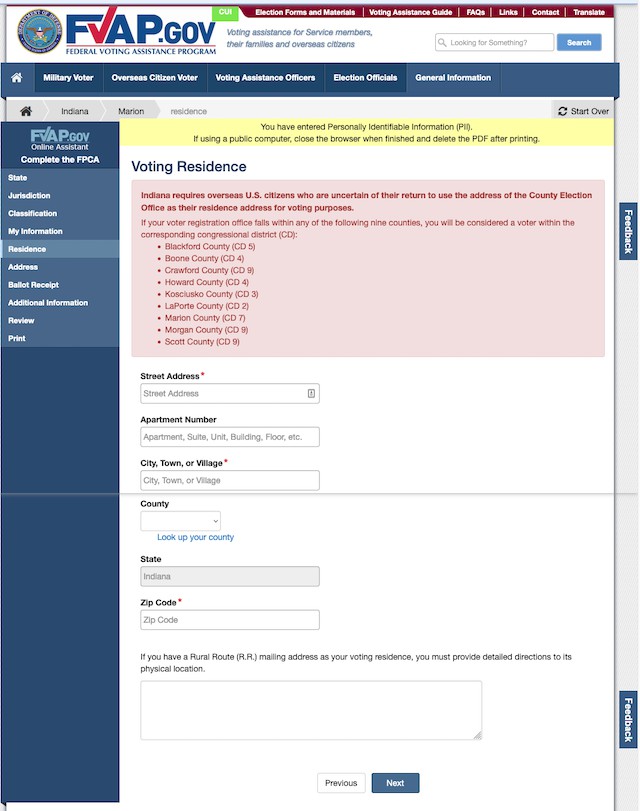
Step 1.7 <New> Mailing Address
Enter your current overseas mailing address.

Step 1.8 – Method to Receive Ballot
Here is where you can indicate how you wish to receive your absentee ballot – via email, postal mail, or fax.
In Chapter 1 of the “Voting Assistance Guide”, it says that “All states must allow you to receive your blank absentee ballot electronically, when requested. This may include email, fax, or online download.” You should still review your options carefully.
If you previously entered your email address and phone number, these will be shown in the lower half of the form.
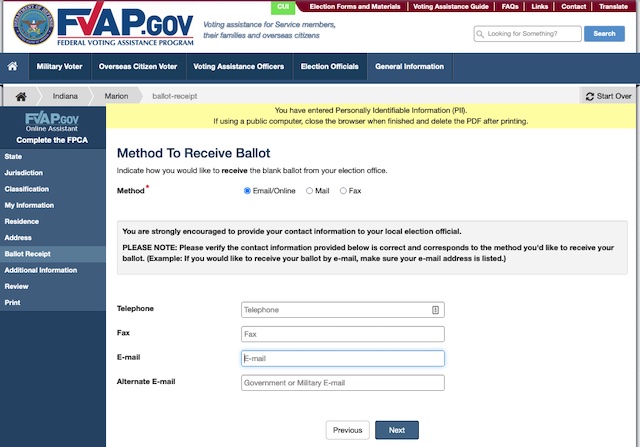
Step 1.9 – Additional Information
Indicate your choice of which elections you wish to participate in.
Once again: Your state / jurisdiction may have limits.
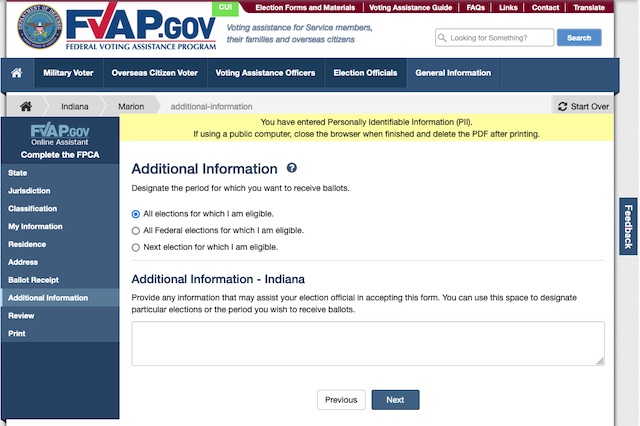
Step 1.10 – Review Your Input
Here is a chance to review all your data and make corrections. The screen is actually longer than shown below.
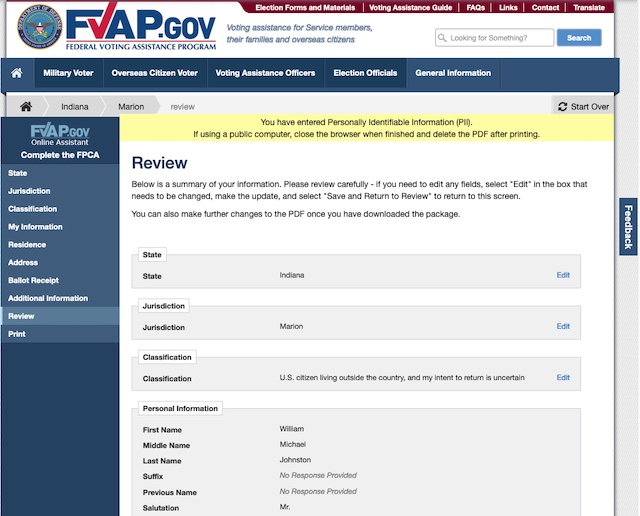
Step 1.11 – Send it in!
Here you can download a PDF of the FPCA form with all your answers. Make sure you sign and date it.
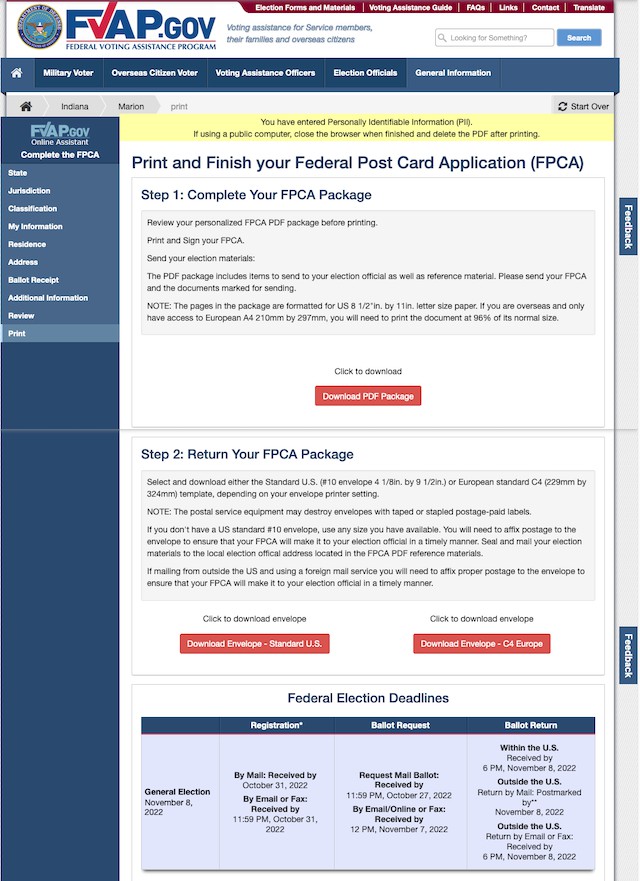
The form will provide details on how you can submit it. Your choices may include:
- Send via postal mail. You’ll be given the address of your local election officials.
- Send via email. The email address of your local election office. Scan your signed form and attach it to an email.
- Fax your FPCA. If available, a fax number will be provided.
Here is an example of a completed FPCA form.
Step 2: Return Your Ballot
We can’t do this one yet, because we haven’t received a ballot. But when it comes, you’ll want to send it back as soon as you receive it – especially if you have to send it via postal mail. Deadlines for your state are published in several places:
- On page 1 of the FPCA document that you download (see the example above)
- On the individual state pages accessible through the “Voting Assistance Guide” page.
You can check the deadlines on the FVAP site. Say more about the timing and mail requirements.
States are required to deliver your absentee ballot no later than 45 days before a federal election. That should provide ample time for you to complete it and return it electronically or via postal mail.
However, if you have not received a ballot by the 45 day deadline, you can use the Federal Write-In Absentee Ballot (FWAB) as your backup plan.
The recommended ‘vote-by’ date for the 2022 General Election is October 24, 2022.
Closing Thoughts
Something you may notice on the site is that almost every important bit of information is repeated multiple times. For me, this was not a problem. Rather than sounding redundant or unnecessary, I found it reassuring that the messages were repeated, and in the proper context.
If offline reading is your preference, you can download the “Voting Assistance Guide”. This is a 500 page pdf file that contains “everything you need to know about absentee voting in all 55 states, territories and the District of Columbia”. It’s essentially a static copy of the web site’s contents.
In addition to the information shown above, the FVAP site also includes
- An extensive page of “Helpful Links” to state and territory election websites, voter registration sites, overseas citizens groups, other federal government sites, and sites for the Democratic and Republican political parties,
- A library of videos about absentee voting,
- A page of “Outreach Materials” – handouts, posters, fact sheets, and media materials related to absentee voting, and
- Literally dozens of other pages of information relevant to US citizens living overseas.
Finally, if you’re a management nerd like me, you might be interested in reading the FVAP’s 5 year strategic plan. It is clearly written, nearly jargon-free, and describes the agency’s mission and goals, it’s vision, and the strategic context within which it operates. The 15 page plan also gives the details of the three goals, including the objectives that support each goal, the strategies for achieving the objectives, and the performance measures they will use to determine how well the objectives were met. It’s the best example of a strategic plan I’ve seen in 40 years.
I hope this post has given you a good idea of what you can find at the FVAP web site and the simplicity of getting registered to vote from outside the US. As I noted earlier, this is an area that is new to me, so I’ll be interested to hear from you if your experience is different from mine. Leave a comment below or send a note via the Contact Us form with your impressions.
Regardless, if you are eligible to vote in US elections this fall, please register and do so. The future of our democracy demands our attention.
Have a great week / Tenha uma ótima semana
Mike
The Writer
* This link is direct to Amazon.com. At the time of this writing (June, 2022), we receive no affiliate payment if you buy a copy. If that changes in the future, we’ll let you know.
A quick note: We love your feedback in the Comments section and we try to respond to every one. But you wouldn’t know unless you came back to the post… and who does that? So we made an improvement to our comments section. You can now check a box to receive an email when anyone replies to a comment you make. Read more about this and other improvements here..
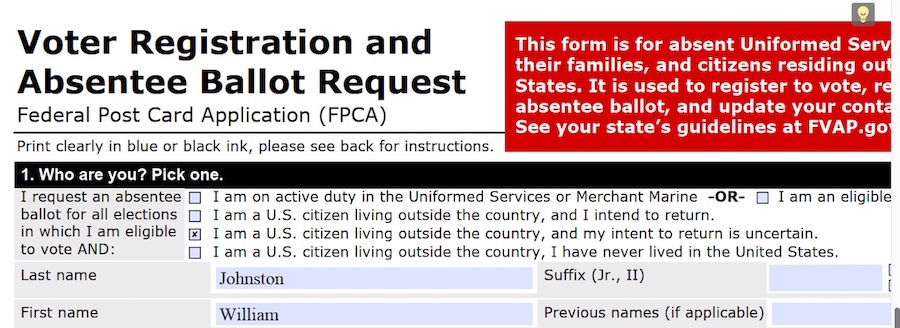

I am answering that I am overseas and do not know if I will return. My state is Wisconsin. I still need to enter an address in Wisconsin while filling out the form.
Should I use my last Wisconsin address even if someone else is currently living there?
Thanks!
David Thoreson
Hi! This is a great post! I just quickly wanted to mention that http://www.votefromabroad.org is another great resource for filing your FPCA and can be a little more user-friendly than the FVAP site, plus there is a dedicated help team there to answer questions. Just another option!
Once again, such a well written and very useful post. I have had this on my “to do” list since I arrived in Lisbon in April because I feel that the future of our country is at stake and now is the most important time in my life to cast my vote. As a resident of Texas, the government there is one of the main reasons we are now in Lisbon-unfortunately. I plan to register today. Thank you again for the time and effort you put into your writing. It is greatly appreciated.